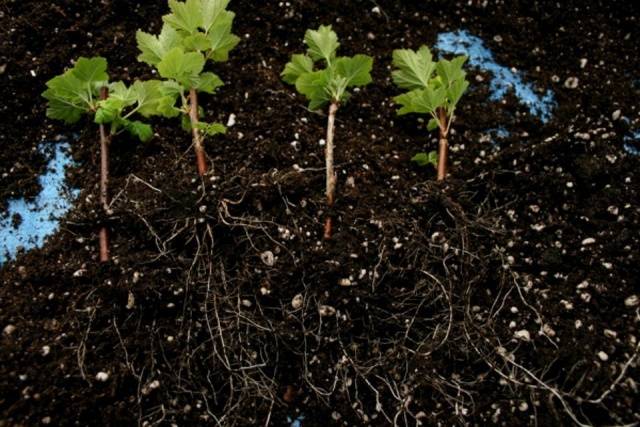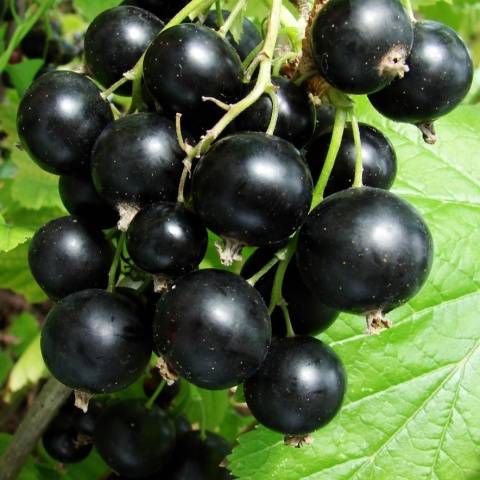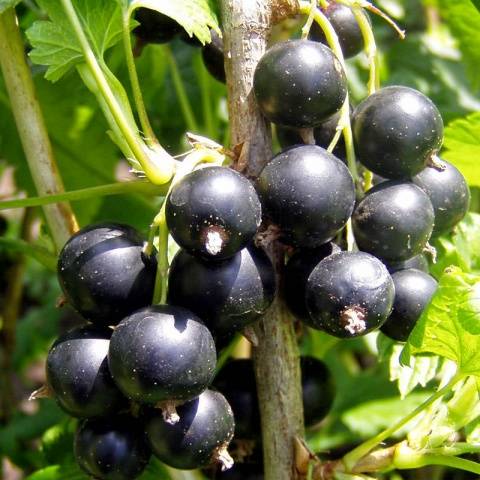Content
Currant Lazy - a variety of Russian selection, which got its name due to late ripening. The variety brings large berries with a dessert taste, suitable for cultivation in summer cottages and garden plots. Lazy currant is resistant to winter frosts and tolerates difficult climatic conditions.
Variety characteristics
Black currant Lazybones bred in the Oryol region. The parent varieties are Minai Shmyrev and Bradthorpe. In 1995, the variety was included in the state register and approved for planting in the Central, North-West region, in the Volga region and in the Urals.
Description of the variety and photo of the currant Lazybones:
- late fruiting;
- powerful vigorous bush;
- a large number of shoots;
- thick and shiny branches;
- large, slightly wrinkled leaves;
- self-fertility 43%.
Characteristics of berries, variety Lazy,:
- weight from 2.5 to 3 g;
- brown-black color;
- sweet refreshing taste;
- tasting score of 4.5 points.
Frost resistance of the Lentyay variety -34 ° С. Under the snow cover, the bushes tolerate lower temperatures. Currants are suitable for growing in regions with a harsh climate.
The disadvantage of the Lazytay variety is the unstable yield. Fruiting is influenced by weather conditions and care. The berries do not ripen at the same time, so the harvest is harvested several times per season. Late currant Lazybones continues to ripen when the fruiting of other varieties is completed.
Up to 1 kg of berries are removed from one bush. With good care, the yield reaches 8-10 kg. The fruits are used fresh, processed to make jams, compotes, and baking fillings. Berries retain their properties when frozen.
Planting culture
In one place, black currant can grow for more than 12 years. The yield of the crop depends on the choice of the place of cultivation. For planting, use healthy plants that are purchased in nurseries. Seedlings can be obtained independently from an adult bush variety Lazy.
Seat selection
Black currant prefers sunny areas located on hills or slopes. In the lowlands, plants are exposed to cold air and moisture.
Although the Lazy Currant is self-fertile, it is recommended to plant it next to other varieties to increase yields. Between the bushes leave from 1 to 1.5 m.
Currants are actively developing in loamy soil with good moisture and air permeability. If the soil is too heavy and poorly permeable to moisture, then its composition is improved by introducing river sand.
Preparation of seedlings
To buy seedlings of the Lazybones variety, it is better to contact specialized centers or nurseries. Healthy seedlings have 1-3 shoots 30 cm long and a strong root system. The plant should not show any signs of damage, growth, dry or rotten areas.
For propagation of the Lazytay variety, shoots 5 mm thick and 15 cm long are chosen in the fall. They are carefully cut and rooted for 2-3 months in a box with wet sand. The cuttings are stored at a temperature of +2 ° C, after which they are buried in the snow or left in the cellar until spring. Plants are planted after the snow melts and the soil warms up.
Reproduction of currants by layering is an easier way. In the spring, a powerful shoot is chosen, which is bent and fixed to the ground.A top 20 cm long is left above the surface, and the shoot itself is covered with soil. During the season, the layers are watered, the soil is mulched with humus. In the fall, they are separated from the bush and planted in a new place.
When transplanting currants, new plants are obtained by dividing the bush. The rhizome is dug up and cut with a clean knife. Places of cuts are processed with crushed coal. Each new bush should have several strong roots.
Work order
Lazy currants are planted at the end of September after leaf fall. It is allowed to postpone planting to spring. Then you need to wait until the snow melts and the soil warms up.
Planting a bush begins with the preparation of a pit. Then they wait 2-3 weeks for the soil to settle.
The order of planting currants Lazy:
- Dig a hole 50 cm in diameter and 40 cm deep.
- Add 2 buckets of compost and 100 g of superphosphate to fertile soil.
- Place the substrate in the hole.
- Place the currant roots in clean water a day before planting.
- Plant a plant, cover the roots with earth.
- Water the bush liberally with warm water.
- Cut off the shoots, leave 2-3 buds on each of them.
Plants are watered every week. The soil is mulched with humus. For the winter, the bushes are spud up to protect them from freezing.
Variety care
According to the description of the variety, photos and reviews, the lazy currant needs care, which increases its yield. The bushes are watered and fed, the soil is loosened and cleaned of weeds... Pruning helps to rejuvenate the bush and stimulate the growth of new shoots. To protect against diseases and pests, preventive treatments are carried out.
Watering
Black currant Lazy man is watered with warm, settled water. The soil is kept moist. However, moisture stagnation is detrimental to the bushes, as it leads to root rot. With a lack of moisture, the ovaries crumble, and the berries become smaller.
Particular attention is paid to watering at the following stages of the development of the bushes:
- in early June, when shoots begin to grow, ovaries appear;
- in the first half of July when the berries are ripe.
For 1 sq. m of the plot, the water consumption is 20 liters. For irrigation, a circular furrow is drawn at a distance of 30 cm from the bush.
After watering, the soil is loosened and weeds are removed. Loosening helps plants absorb moisture and nutrients. Mulching the soil with humus or peat helps to reduce the intensity of irrigation.
Top dressing
Blackcurrant Lazybones are fed with organics and minerals. It is best to alternate between different types of dressings.
Bushes under 3 years old in early spring are fertilized with 40 g of urea, which is embedded in the soil to a depth of 30 cm. Nitrogen fertilization promotes the growth of shoots. For adult bushes of the Lazyday variety, 25 g of urea is enough.
Every 2 years, the soil under the bushes is dug up and fertilized with humus. When mulching the soil with organic matter during the season, you can do without additional introduction of humus.
Pruning
Over time, the black currant Lazy grows. Shoots located inside the shrub do not receive sufficient lighting. As a result, yield is lost and the taste of berries deteriorates.
Dry, frozen and diseased shoots are cut annually. The main crop of black currant is harvested from annual shoots. Therefore, branches older than 4 years are subject to pruning.
Pruning is carried out in early spring before bud break or in autumn after leaf fall. In summer, weak root growth is eliminated, which takes up a lot of nutrients from the main bush.
Gradually, in adult bushes, the fruit buds are shifted to the upper part of the shoots. In the spring, the tops are pinched to stop their growth and get powerful fruiting shoots.
Protection against diseases and pests
Lazy currant is resistant to anthracnose and powdery mildew. For the prevention of diseases, the bushes are sprayed with a solution of the drug Nitrofen. Processing is carried out in early spring before the beginning of the growing season.
During the growing season, chemicals are used with caution. For spraying, the drug Fundazol is suitable, which destroys the cells of pathogenic fungi. The last treatment is performed 3 weeks before harvesting the berries. In late autumn, after pruning, the bushes are re-processed.
Variety Lazybear is susceptible to attack by kidney mites, moths, aphids, caterpillars. The drugs Karbofos and Actellik are effective against pests. Preventive treatments are carried out in spring and autumn in warm calm weather.
Gardeners reviews
Conclusion
Lazy currant is a decent fruitful variety, suitable for planting in various regions. Lazytay berries are valued for their dessert taste and versatility. Saplings are purchased from nurseries. For reproduction, you can use an adult currant bush. High yield is provided by regular care: watering, fertilizing, pruning bushes. Black currant is little susceptible to disease, if you follow agricultural techniques and carry out preventive treatments.














Hello. I think that you were mistaken when advising to choose cuttings 5 cm thick and 15 cm long for propagation. I agree with the length, but the thickness, in my opinion, should not be 5 cm, but 5-6 mm.
Galina, thank you!